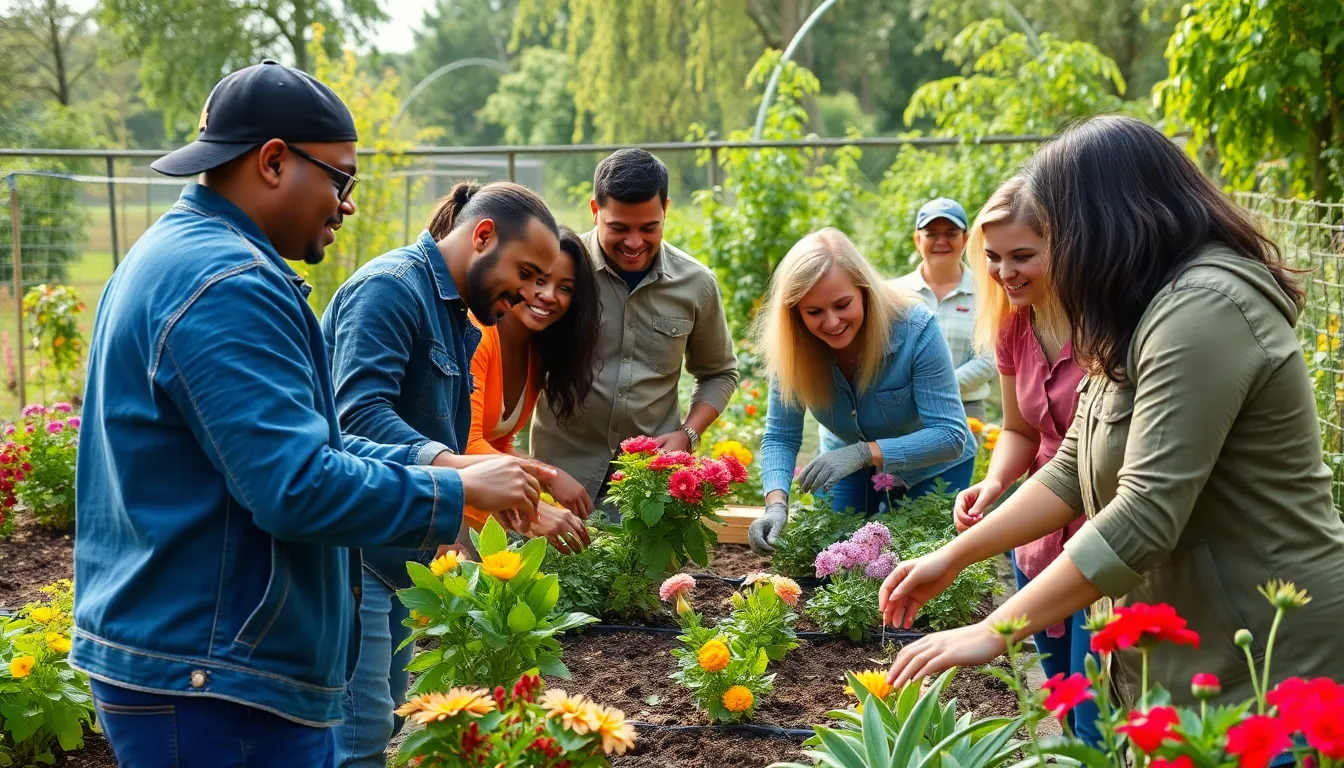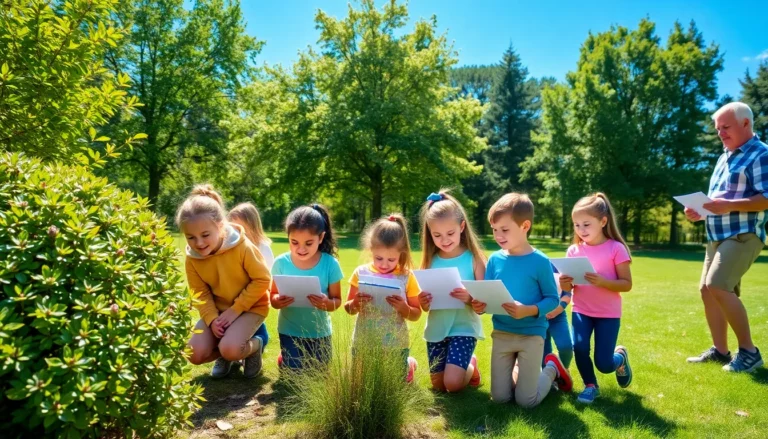Table of Contents
ToggleIn a world where everyone seems to be glued to their screens, collaborative community projects are the refreshing antidote we didn’t know we needed. Imagine a vibrant tapestry of people coming together, armed with paintbrushes, shovels, and a shared vision. They’re not just building parks or painting murals; they’re crafting connections that make neighborhoods feel like home.
These projects don’t just transform spaces; they transform lives. When folks unite for a common cause, magic happens. Laughter fills the air, friendships blossom, and before you know it, that shy neighbor from down the street is now your partner in crime for the next big idea. So, roll up those sleeves and dive into the world of collaborative community projects. Who knew making a difference could be this much fun?
Overview of Collaborative Community Projects
Collaborative community projects significantly enhance local environments. These initiatives engage residents in activities that transform public spaces, creating parks and murals that reflect community identity. Residents enjoy the opportunity to participate in decision-making processes, which fosters a sense of ownership. Such involvement strengthens interpersonal relationships among neighbors, building strong social networks.
Community gardens exemplify collaboration, providing fresh produce while encouraging teamwork. Participants learn about sustainable gardening practices. Events, like clean-up drives, focus on beautifying neighborhoods and instilling pride in community spaces. Volunteers contribute their time and effort, demonstrating commitment to local development.
Additionally, collaborative events, such as festivals and art walks, unite various community members. These gatherings create platforms for local artists and entrepreneurs, showcasing talent and promoting cultural exchange. Inclusivity and participation become priorities, nurturing diversity within the community.
Financial resources often accompany these projects, with grants and sponsorships available to support initiatives. Local governments sometimes provide assistance, ensuring successful project completion. Engaging diverse stakeholders increases the potential for achieving meaningful community change.
Success stories illustrate the positive outcomes of such projects. Research shows that neighborhoods with ongoing collaborative efforts experience lower crime rates and improved mental well-being. Social connections strengthen the overall resilience of the community, demonstrating the long-term benefits of investing in collective action.
Importance of Collaborative Community Projects

Collaborative community projects play a crucial role in enhancing social fabric and collective well-being. They create an environment where residents actively participate in fostering community ties.
Building Trust and Relationships
Building trust is essential for strong communities. Collaborative projects facilitate interactions that help individuals connect and develop relationships. Projects like community gardens or murals encourage teamwork, promoting a sense of belonging among residents. Shared goals and experiences cultivate bonds that extend beyond the project itself. Moreover, participation in events fosters openness and collaboration. People learn to rely on one another, strengthening community resilience. Ultimately, these relationships lay the groundwork for a supportive network, contributing to long-term neighborhood stability.
Promoting Inclusivity and Diversity
Promoting inclusivity is vital in community engagement. Collaborative projects create spaces where diverse voices are heard and valued. Different perspectives enrich discussions, leading to innovative solutions that meet everyone’s needs. Community festivals and clean-up drives showcase local talent while bringing people together, breaking down barriers. Involving various cultural groups encourages understanding and helps address social issues collectively. An inclusive atmosphere nurtures respect and acceptance among residents, creating a vibrant and dynamic community. Active participation promotes a sense of ownership, empowering individuals from all backgrounds to contribute meaningfully.
Key Elements of Successful Projects
Successful collaborative community projects hinge on several key elements that ensure their effectiveness and sustainability. Strong communication and stakeholder engagement play critical roles in achieving these goals.
Effective Communication Strategies
Clear communication establishes a foundation for community collaboration. Providing regular updates encourages transparency and fosters trust among participants. Utilizing multiple channels, such as social media and community meetings, reach diverse audiences. Active listening helps address community concerns and incorporate feedback into decision-making processes. Additionally, creating a shared platform allows residents to express their ideas and suggestions openly.
Engaging Local Stakeholders
Involving local stakeholders enhances project relevance and success. Identifying key community members, such as leaders and organizations, strengthens partnerships. Inclusivity ensures varied perspectives contribute to project planning and execution. Building relationships with civic groups and businesses can secure vital resources and support. Acknowledging stakeholders’ contributions fosters a sense of ownership, encouraging long-lasting engagement in community initiatives.
Challenges Faced in Collaborative Efforts
Collaborative community projects encounter several challenges that can hinder their success. Understanding these obstacles helps improve planning and implementation.
Coordinating Different Perspectives
Coordinating diverse perspectives often complicates collaborative efforts. Each participant may bring unique ideas and priorities, sometimes leading to conflicts. It’s vital to establish a common vision early on, ensuring everyone is aligned. Facilitation techniques can help manage discussions, promoting open dialogue. Incorporating feedback from various stakeholders enhances inclusivity and ownership. Engaging community mediators can also bridge gaps among conflicting viewpoints, fostering a sense of unity.
Funding and Resource Allocation
Funding and resource allocation consistently pose challenges for collaborative projects. Securing adequate funding can be a lengthy process, often relying on grants or sponsorships. Local governments sometimes contribute, but these funds are not guaranteed. Effective budgeting plays a crucial role in resource management, requiring transparency and planning. Communities can explore partnerships with businesses to unlock additional resources. Prioritizing deliverables based on available funding enhances project feasibility and sustainability.
Case Studies of Successful Collaborative Projects
Successful collaborative community projects demonstrate practical applications of collective action. One example is the “Community Garden Initiative” in Brooklyn, New York. Residents transformed vacant lots into vibrant gardens that provide access to fresh produce, promote sustainability, and foster social interactions among neighbors.
Another notable project is the “City Clean-Up Campaign” in Austin, Texas. Local organizations and volunteers came together to beautify parks and public spaces. Participation increased community pride, encouraging residents to take ownership of their environment.
The “Mural Project” in Philadelphia illustrates the power of art in uniting communities. Artists collaborated with residents to create murals reflecting local culture and history. This initiative attracted tourism while enhancing neighborhood identity.
In Seattle, the “Festival of Cultures” brought diverse communities together. Various organizations collaborated to showcase cultural performances, food, and art. Attendance not only celebrated diversity but also fostered connections among participants.
Collaborative efforts often overcome challenges through effective communication. In the “Parks Revitalization Project” in Chicago, regular community meetings ensured all voices were heard. This engagement reduced conflicts and promoted shared goals.
Funding plays a vital role in project sustainability. The “Neighborhood Improvement Fund” in San Francisco exemplifies how grants support local initiatives. Financial resources enabled ongoing enhancements to community spaces.
These case studies highlight successful collaborative projects that enrich communities. Engaging residents generates connections, strengthens local networks, and enhances overall well-being. Community-driven efforts thrive when diverse voices intertwine, leading to innovative solutions to common challenges.
Collaborative community projects serve as a vital force in strengthening neighborhoods and enhancing social connections. By engaging residents in meaningful initiatives, these projects foster a sense of belonging and ownership. They create opportunities for diverse voices to be heard while promoting inclusivity and respect among community members.
The positive outcomes of these efforts extend beyond the immediate project, contributing to long-term stability and well-being. As communities continue to embrace collaboration, they’ll likely discover innovative solutions to shared challenges. The ongoing engagement in these initiatives not only beautifies public spaces but also cultivates relationships that enrich lives. It’s clear that when individuals come together, they can transform their communities for the better.






